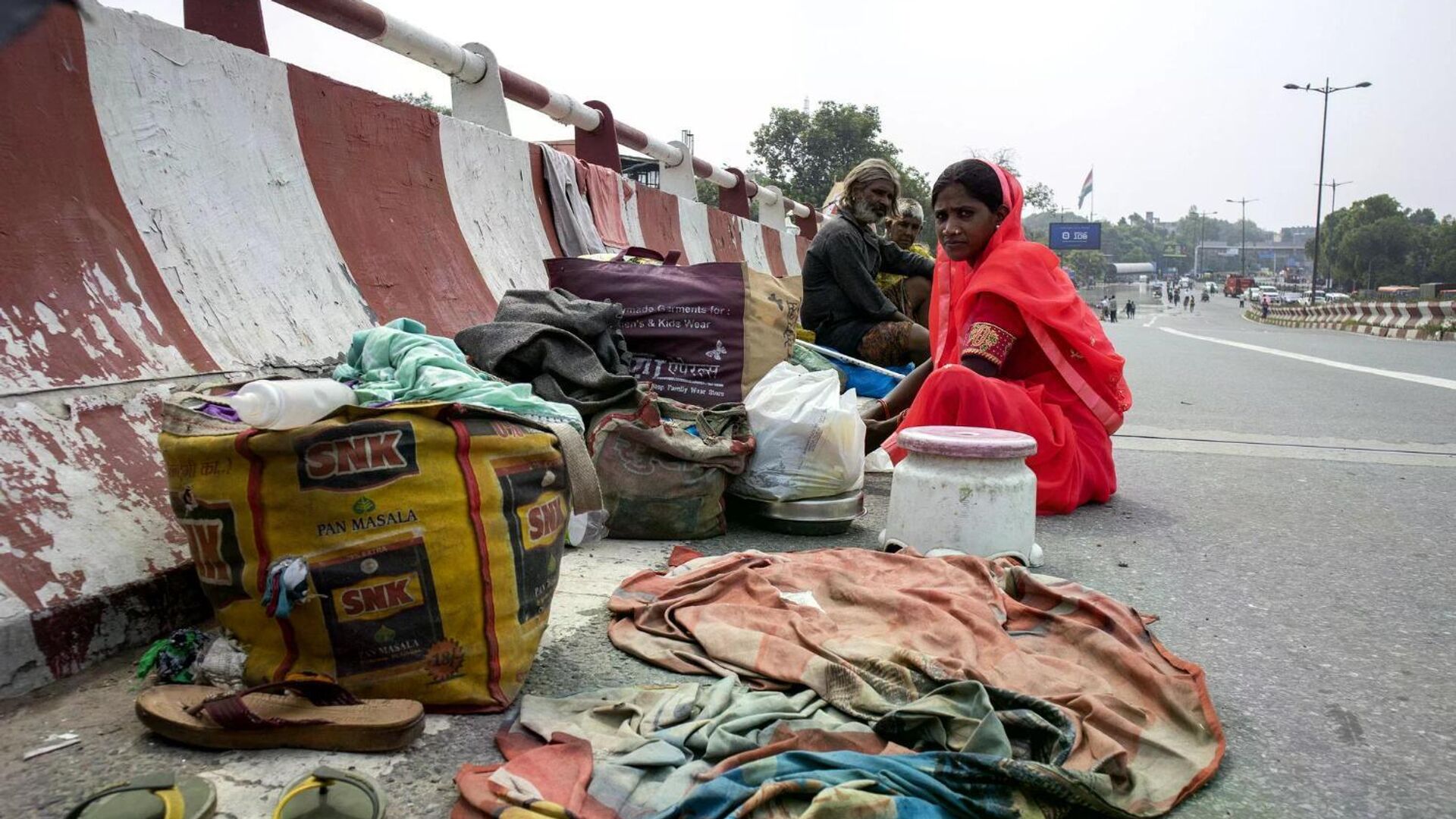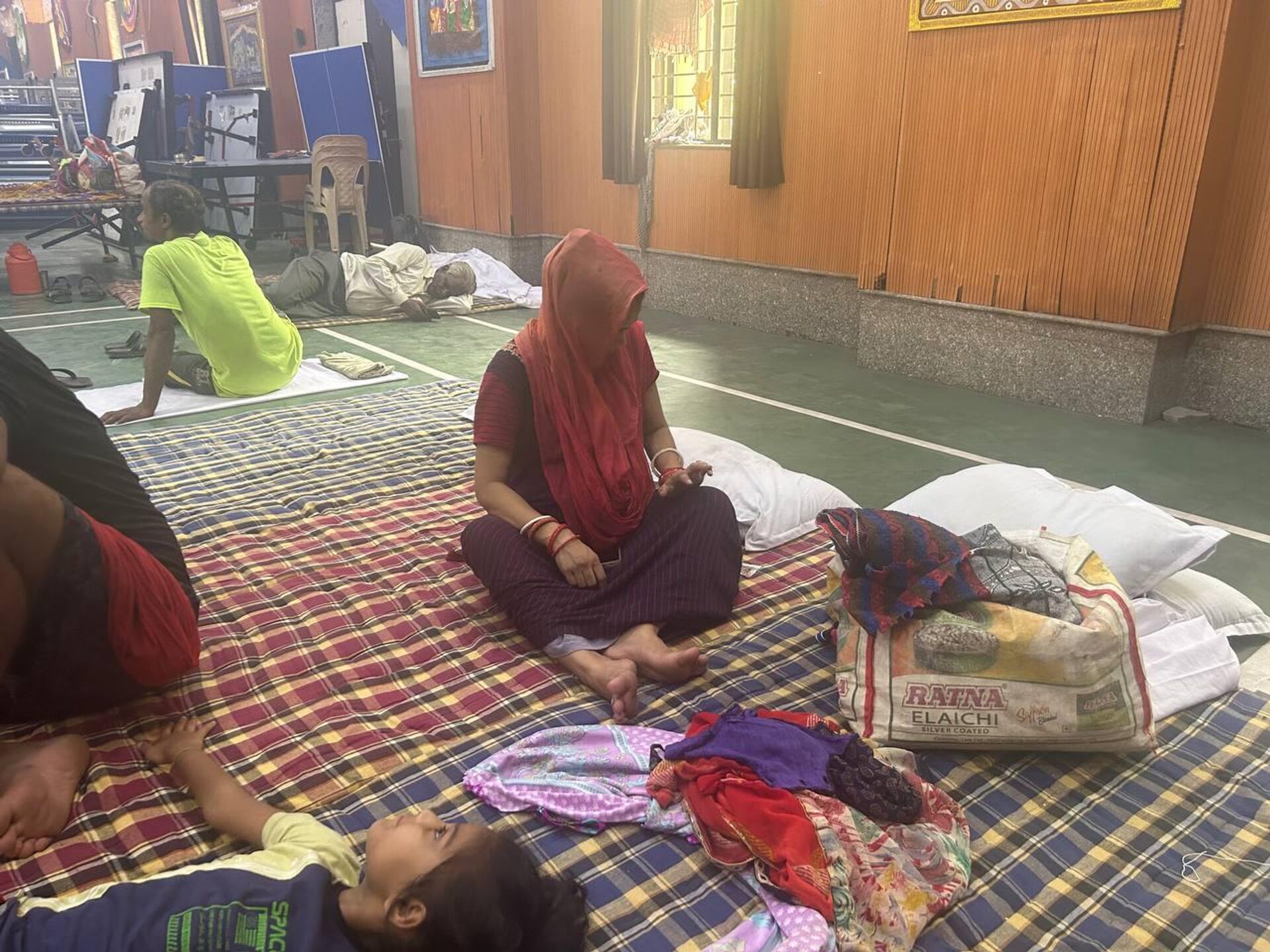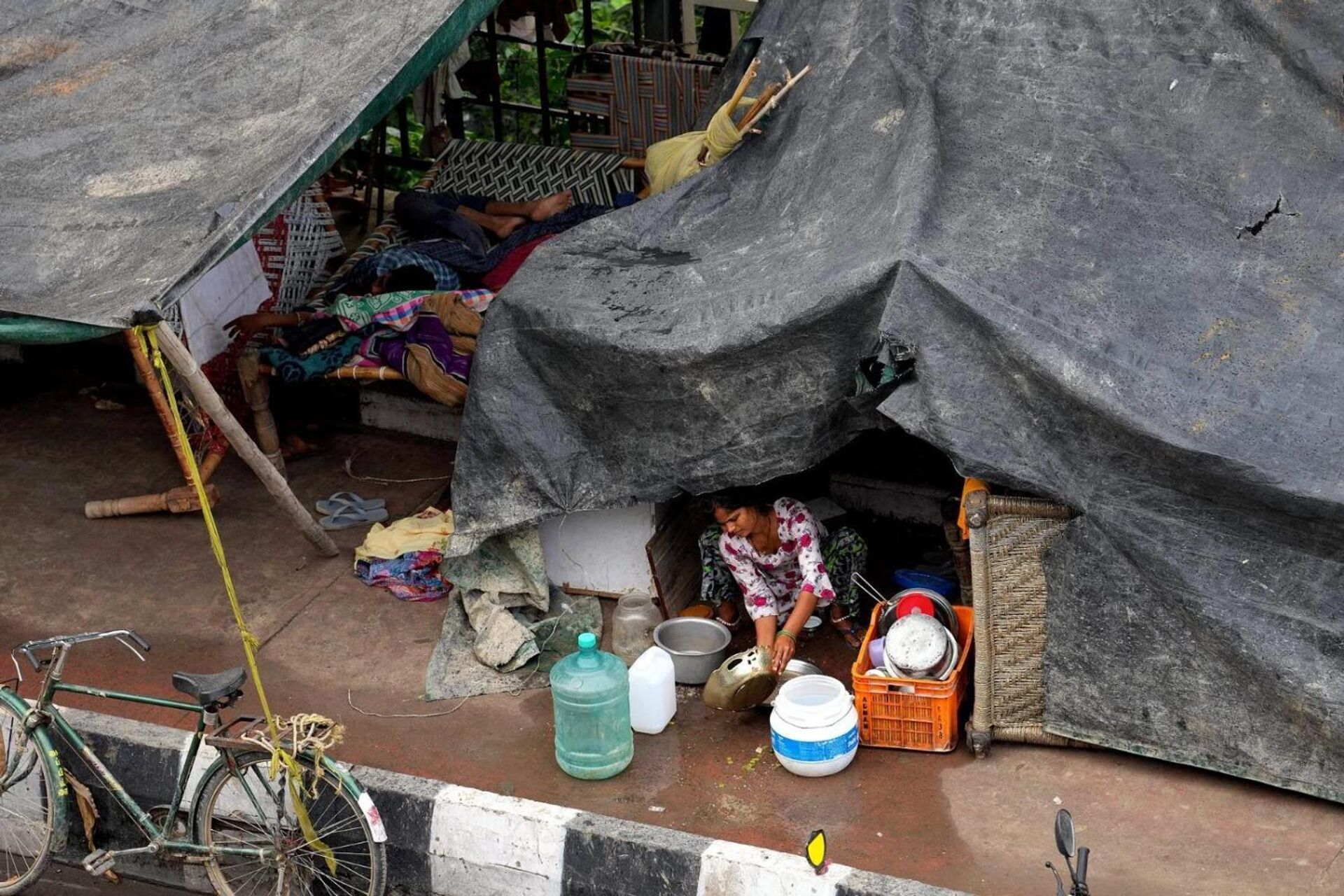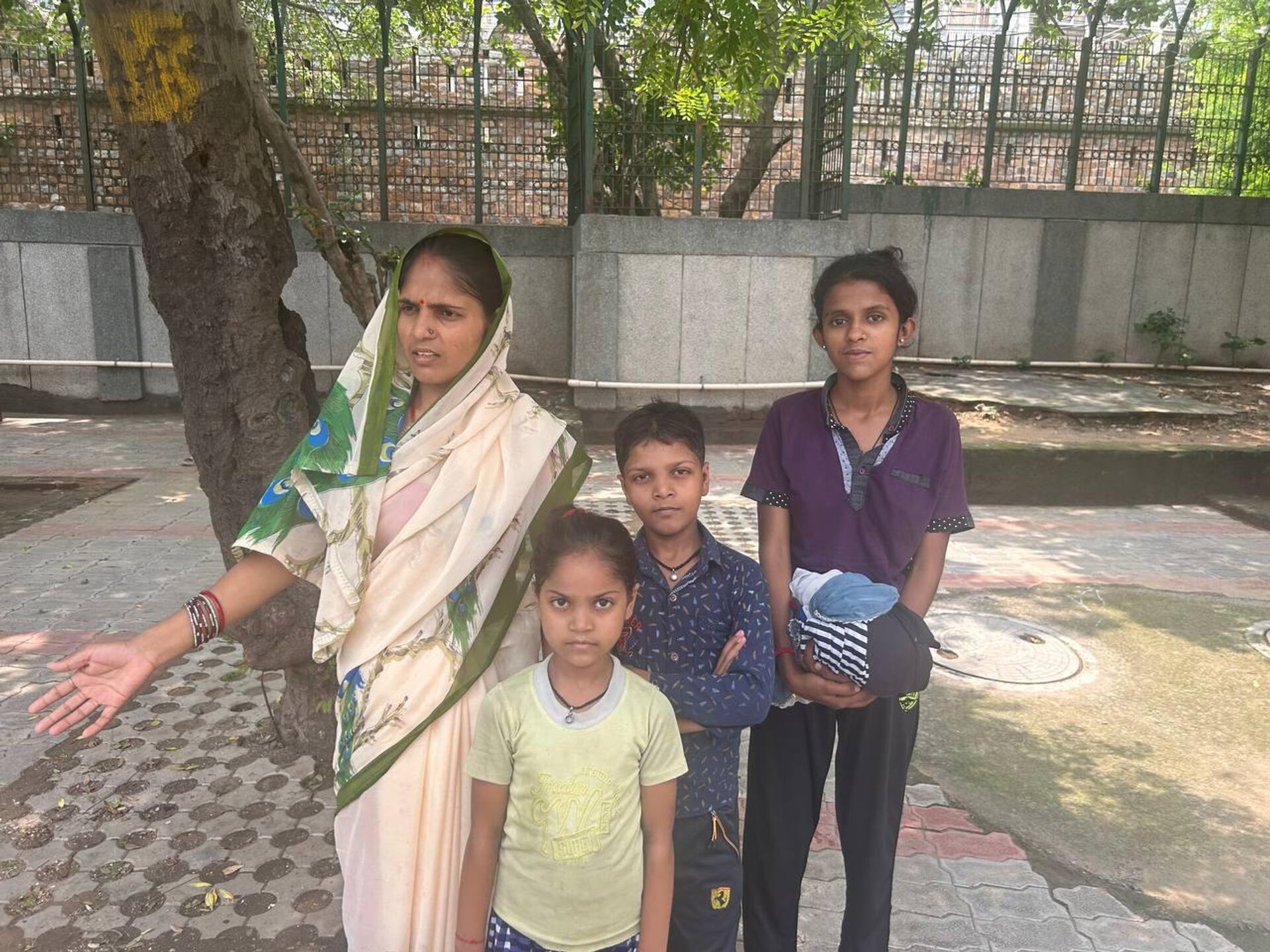https://sputniknews.in/20230715/nowhere-to-go-lost-everything-displaced-families-living-at-delhis-floodplains-3010498.html
‘Nowhere to Go, Lost Everything’: Displaced Families Living at Delhi’s Floodplains
‘Nowhere to Go, Lost Everything’: Displaced Families Living at Delhi’s Floodplains
Sputnik India
Forty-seven-year-old Sita Devi, in the wee hours of Sunday, shifted to the Delhi government's temporary shelter home when her house in Jamuna Bazaar (also known as Yamuna Bazaar) became submerged.
2023-07-15T08:00+0530
2023-07-15T08:00+0530
2023-07-15T08:00+0530
new delhi
delhi
floods
climate change
arvind kejriwal
haryana
sputnik exclusives
monsoon rains
himachal pradesh
uttar pradesh
https://cdn1.img.sputniknews.in/img/07e7/07/0e/3009256_0:78:1500:922_1920x0_80_0_0_92adafbf3a41984f37ab6f0da15ed107.jpg
Forty-seven-year-old Sita Devi, in the wee hours of Sunday, shifted to the Delhi government's temporary shelter home when her house in Jamuna Bazaar (also known as Yamuna Bazaar) became submerged.First, they were on a bridge across the River Yamuna in a makeshift home -- made of a tarpaulin sheet. Later, as the water level continued to rise, they were shifted to a government school in the nearby Mori Gate area late Thursday at around 3 am.Sita Devi is scared for her daughter, who is nine months pregnant. So, now she has to make so many adjustments, “Her due date is July 15. If the water level in Yamuna continues to rise, how will we reach the hospital?”When the river swelled and the flood water entered locals' houses, the city government evacuated about 16,000 people from areas like Khadar, Jamuna Bazaar, the Yamuna floodplains near Akshardham area, etc.Most of these people told Sputnik that they lived in shanties or Kutcha houses, which drifted after the water level rose. In most of these places, people were seen wading through waist-deep water to collect food, as the women and children sat on the roofs of the brick-and-mortar houses.While only a few have been shifted to concrete structures, others are living in makeshift homes, made of tarpaulin sheets. The government has made arrangements for food, drinking water, and tents in some parts. But many people are still seeking relief.Thirty-eight-year-old Salman is worried about his auto rickshaw, which he had to leave at home, as authorities asked him to move his family to a safer place. Salman, the sole bread earner in his family, had to move out along with his wife and three kids: "I lost everything – home, documents, my source of earning bread. A house has everything – kitchen, sleeping place and whatnot. We’ve got to start afresh.”Meanwhile, near Akshardham, where about 100-200 families reside in groups, they live in makeshift tents along the road's edge.“On Tuesday, we were asked to evacuate the place. Where? They didn’t bother to tell,” Shakti Kumari said.All these slum dwellers remained uncertain when and how they’ll return to their homes or start life afresh.Delhi Chief Minister Arvind Kejriwal blamed neighboring state Haryana and the federal government for the release of water from an irrigation facility, Hathni Kund Barrage, upstream from Delhi. However, the Haryana government refuted the allegation, saying it's a barrage, not a dam, which can store water.Displacement due to climate changeDisplacement due to extreme weather is emerging in recent times, impacting the most vulnerable. The Internal Displacement Monitoring Centre, in its report, said that extreme weather in South Asia led to the internal displacement of 12.5 million people in 2022. Ninety percent of them are due to floods.Meanwhile, half a million people in India’s north-eastern state Assam were displaced due to the ongoing flood since June.In 2022, Pakistan witnessed a record-breaking flood in which hundreds of thousands were displaced and thousands died.Many Indian states, including Himachal Pradesh and Uttarakhand, are witnessing torrential rains this season, in which it’s estimated that 145 people have died in north India only.Another report, Groundswell, in 2021 estimated that as many as 216 million people could move within their own countries due to slow-onset climate change impacts by 2050.
https://sputniknews.in/20230522/india-and-nigeria-to-see-largest-populations-exposed-to-extreme-heat-2106747.html
new delhi
delhi
haryana
himachal pradesh
uttar pradesh
uttaranchal
uttarakhand
Sputnik India
feedback.hindi@sputniknews.com
+74956456601
MIA „Rossiya Segodnya“
2023
Deexa Khanduri
https://cdn1.img.sputniknews.in/img/07e6/0c/13/138923_52:0:533:481_100x100_80_0_0_cadf23d341691fc65ff2b22fd1afe584.jpg
Deexa Khanduri
https://cdn1.img.sputniknews.in/img/07e6/0c/13/138923_52:0:533:481_100x100_80_0_0_cadf23d341691fc65ff2b22fd1afe584.jpg
News
en_IN
Sputnik India
feedback.hindi@sputniknews.com
+74956456601
MIA „Rossiya Segodnya“
Delhi Dwellers Open Up to Sputnik About Their Challenges as As Yamuna River Swells
Sputnik India
Delhi Dwellers Open Up to Sputnik About Their Challenges as As Yamuna River Swells
2023-07-15T08:00+0530
true
PT1M40S
Sputnik India
feedback.hindi@sputniknews.com
+74956456601
MIA „Rossiya Segodnya“
Deexa Khanduri
https://cdn1.img.sputniknews.in/img/07e6/0c/13/138923_52:0:533:481_100x100_80_0_0_cadf23d341691fc65ff2b22fd1afe584.jpg
yamuna river water level at all-time high, central water commission, flood-monitoring portal, old railway bridge, people in low-lying areas shifted, continuous rainfall in the upper catchment areas, hathnikund barrage, sharp rise of the river, 45 boats deployed for awareness, evacuation and rescue work, ngos roped in to provide relief to the evacuated people, flood-like situation in delhi
yamuna river water level at all-time high, central water commission, flood-monitoring portal, old railway bridge, people in low-lying areas shifted, continuous rainfall in the upper catchment areas, hathnikund barrage, sharp rise of the river, 45 boats deployed for awareness, evacuation and rescue work, ngos roped in to provide relief to the evacuated people, flood-like situation in delhi
‘Nowhere to Go, Lost Everything’: Displaced Families Living at Delhi’s Floodplains
Deexa Khanduri
Sputnik correspondent
This week, the water level in River Yamuna surged to a 45-year high—208.66 metres (684.5 feet), submerging thousands of houses in floodplains or low-lying areas near the river in Delhi.
Forty-seven-year-old Sita Devi, in the wee hours of Sunday, shifted to the Delhi government's temporary shelter home when her house in Jamuna Bazaar (also known as Yamuna Bazaar) became submerged.
First, they were on a bridge across the
River Yamuna in a
makeshift home -- made of a tarpaulin sheet. Later, as the
water level continued to rise, they were shifted to a government school in the nearby Mori Gate area late Thursday at around 3 am.
Sita Devi is scared for her daughter, who is nine months pregnant. So, now she has to make so many adjustments, “Her due date is July 15. If the water level in Yamuna continues to rise, how will we reach the hospital?”
When the river swelled and the flood water entered locals' houses, the city government evacuated about 16,000 people from areas like Khadar, Jamuna Bazaar, the Yamuna floodplains near Akshardham area, etc.
Most of these people told Sputnik that they lived in shanties or Kutcha houses, which drifted after the water level rose. In
most of these places, people were seen wading through waist-deep water to collect food, as the
women and children sat on the roofs of the brick-and-mortar houses.
While only a few have been shifted to concrete structures, others are living in makeshift homes, made of tarpaulin sheets. The government has
made arrangements for food, drinking water, and tents in some parts. But many people are still seeking relief.
Thirty-eight-year-old Salman is worried about his auto rickshaw, which he had to leave at home, as authorities asked him to move his family to a safer place. Salman, the sole bread earner in his family, had to move out along with his wife and three kids: "I lost everything – home, documents, my source of earning bread. A house has everything – kitchen, sleeping place and whatnot. We’ve got to start afresh.”
Meanwhile, near Akshardham, where about 100-200 families reside in groups, they live in makeshift tents along the road's edge.
“On Tuesday, we were asked to evacuate the place. Where? They didn’t bother to tell,” Shakti Kumari said.
All these slum dwellers remained uncertain when and how they’ll return to their homes or start life afresh.
Delhi Chief Minister Arvind Kejriwal blamed neighboring state Haryana and the federal government for the release of water from an irrigation facility, Hathni Kund Barrage, upstream from Delhi. However, the Haryana government refuted the allegation, saying it's a barrage, not a dam, which can store water.
Displacement due to climate change
Displacement due to extreme weather is emerging in recent times, impacting the most vulnerable.
The Internal Displacement Monitoring Centre, in its report, said that extreme weather in South Asia led to the
internal displacement of 12.5 million people in 2022. Ninety percent of them are due to floods.
Meanwhile, half a million people in India’s north-eastern state Assam were displaced due to the ongoing flood since June.
In 2022, Pakistan witnessed a record-breaking flood in which hundreds of thousands were displaced and thousands died.
Many Indian states, including Himachal Pradesh and Uttarakhand, are witnessing torrential rains this season, in which it’s estimated that 145 people have died in north India only.
Another report
, Groundswell, in 2021 estimated that as many as 216 million people could move within their own countries due to slow-onset climate change impacts by 2050.







